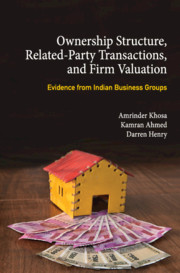 Ownership Structure, Related Party Transactions, and Firm Valuation
Ownership Structure, Related Party Transactions, and Firm Valuation Book contents
- Frontmatter
- Contents
- List of Tables
- 1 Introduction
- 2 The Evolution of Business Groups, Institutional Framework in India, and Related-Party Transactions
- 3 Theory and Literature Review
- 4 Hypotheses Development
- 5 Research Methods
- 6 Descriptive Statistics
- 7 Empirical Results
- 8 Additional Tests
- 9 Implications of the Study and Conclusion
- Appendix 1 List of Sample Firms
- Appendix 2 List of Business Groups
- References
- Index
5 - Research Methods
Published online by Cambridge University Press: 26 April 2019
- Frontmatter
- Contents
- List of Tables
- 1 Introduction
- 2 The Evolution of Business Groups, Institutional Framework in India, and Related-Party Transactions
- 3 Theory and Literature Review
- 4 Hypotheses Development
- 5 Research Methods
- 6 Descriptive Statistics
- 7 Empirical Results
- 8 Additional Tests
- 9 Implications of the Study and Conclusion
- Appendix 1 List of Sample Firms
- Appendix 2 List of Business Groups
- References
- Index
Summary
This chapter presents a detailed discussion of the research methods used in the study. This chapter is organized as follows. The first section explains the procedures employed to select the data sample. The next section provides the description of the data, which includes the selection of firms based on group membership and industry classification. The last section explains the empirical models employed to measure the valuation of the effects of group membership, ownership structure, and RPTs.
Sampling procedures
Sample selection
The Prowess database developed by the Centre of Monitoring Indian Economy (CMIE) is used to identify the sample firms. We identify two parameters to select firms for the analysis. These are: (a) firms belonging to Indian Business Groups, and (b) firms that are listed on the BSE. On 20 November 2012, the initial search using the Prowess database identified 8,420 group firms, of which, only 1,640 firms were found to be listed. As financial firms are subject to different regulation, we chose to exclude financial firms from the sample. After excluding them, 1,443 firms remained. We randomly selected 400 firms from them. The data we require for the analysis (financial, ownership, and corporate governance) was not available for all 400 firms. There were 83 firms with missing information in the Prowess database. After deleting those firms from the sample, there were 317 firms, which is approximately 22 per cent of the total population (1,443 firms). The details of sample firms are provided in Panel A of Table 5.1. Appendix 1 provides names of firms included in the sample. Information on RPTs and corporate governance is hand collected.
Total sample firms belong to 156 business groups. The average firms per group is two, with a minimum of one firm per group and a maximum of eight firms per group. Appendix 2 provides the names of these groups and the number of firms per group.
We examine the group firm ownership structure and RPTs for sample firms for the recent five-year period from the year ending in March 2008 to March 2012. Our sample contains 1,530 firm-year observations. The number of individual year observations varies because of missing variables for some firms in particular years during the selected period and details are provided in Table 5.1 (Panel B).
- Type
- Chapter
- Information
- Ownership Structure, Related Party Transactions, and Firm ValuationEvidence from Indian Business Groups, pp. 80 - 96Publisher: Cambridge University PressPrint publication year: 2019
